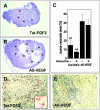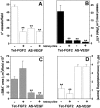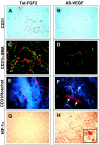Distinct role of fibroblast growth factor-2 and vascular endothelial growth factor on tumor growth and angiogenesis
- PMID: 12759248
- PMCID: PMC1868139
- DOI: 10.1016/S0002-9440(10)64325-8
Distinct role of fibroblast growth factor-2 and vascular endothelial growth factor on tumor growth and angiogenesis
Abstract
Tumors express more than a single angiogenic growth factor. To investigate the relative impact of fibroblast growth factor-2 (FGF-2) and vascular endothelial growth factor (VEGF) on tumor growth and neovascularization, we generated tumor cell transfectants differing for VEGF and/or FGF-2 expression. Human endometrial adenocarcinoma HEC-1-B-derived Tet-FGF-2 cells that express FGF-2 under the control of the tetracycline-responsive promoter (Tet-off system) were further transfected with a VEGF(121) anti-sense (AS-VEGF) cDNA. Next, Tet-FGF-2 and AS-VEGF/Tet-FGF-2 cells were transplanted subcutaneously in nude mice that received tetracycline or not in the drinking water. Simultaneous expression of FGF-2 and VEGF in Tet-FGF-2 cells resulted in fast-growing lesions characterized by high blood vessel density, patency and permeability, and limited necrosis. Blood vessels were highly heterogeneous in size and frequently associated with pericytes. Inhibition of FGF-2 production by tetracycline caused a significant decrease in tumor burden paralleled by a decrease in blood vessel density and size. AS-VEGF expression resulted in a similar reduction in blood vessel density associated with a significant decrease in pericyte organization, vascular patency, and permeability. The consequent decrease in tumor burden was paralleled by increased tumor hypoxia and necrosis. A limited additional inhibitory effect was exerted by simultaneous down-regulation of FGF-2 and VEGF expression. These findings demonstrate that FGF-2 and VEGF stimulate vascularization synergistically but with distinctive effects on vessel functionality and tumor survival. Blockade of either one of the two growth factors results in a decrease in blood vessel density and, consequently, in tumor burden. However, inhibition of the expression of VEGF, but not of FGF-2, affects also vessel maturation and functionality, leading to tumor hypoxia and necrosis. Our experimental model represents an unique tool to investigate anti-neoplastic therapies in different angiogenic environments.
Figures






Similar articles
-
[Inhibitation of tumor angiogenesis, growth and metastasis by blocking VEGF paracrine pathway].Sheng Wu Hua Xue Yu Sheng Wu Wu Li Xue Bao (Shanghai). 2002 Mar;34(2):165-70. Sheng Wu Hua Xue Yu Sheng Wu Wu Li Xue Bao (Shanghai). 2002. PMID: 12006990 Chinese.
-
Modulation of tumor angiogenesis by conditional expression of fibroblast growth factor-2 affects early but not established tumors.Cancer Res. 2001 Jan 1;61(1):309-17. Cancer Res. 2001. PMID: 11196179
-
[Inhibition of K562 cell growth and tumor angiogenesis in nude mice by antisense VEGF(121) cDNA transfection].Zhonghua Xue Ye Xue Za Zhi. 2002 Apr;23(4):179-82. Zhonghua Xue Ye Xue Za Zhi. 2002. PMID: 12133452 Chinese.
-
The role of FGF and VEGF in angioblast induction and migration during vascular development.Dev Dyn. 2001 Jan;220(1):1-17. doi: 10.1002/1097-0177(2000)9999:9999<::AID-DVDY1087>3.0.CO;2-2. Dev Dyn. 2001. PMID: 11146503 Review.
-
Vascular endothelial growth factor and its receptors in multiple myeloma.Leukemia. 2003 Oct;17(10):1961-6. doi: 10.1038/sj.leu.2403076. Leukemia. 2003. PMID: 14513045 Review.
Cited by
-
FGF receptor inhibitors: role in cancer therapy.Curr Oncol Rep. 2012 Apr;14(2):111-9. doi: 10.1007/s11912-012-0225-0. Curr Oncol Rep. 2012. PMID: 22311684 Review.
-
Effects of LY294002 on the invasiveness of human gastric cancer in vivo in nude mice.World J Gastroenterol. 2009 Oct 28;15(40):5044-52. doi: 10.3748/wjg.15.5044. World J Gastroenterol. 2009. PMID: 19859997 Free PMC article.
-
Inhibition of adenovirus-mediated human MAGE-D1 on angiogenesis in vitro and in vivo.Mol Cell Biochem. 2007 Jun;300(1-2):89-99. doi: 10.1007/s11010-006-9373-6. Epub 2006 Dec 6. Mol Cell Biochem. 2007. PMID: 17149546
-
A proangiogenic signature is revealed in FGF-mediated bevacizumab-resistant head and neck squamous cell carcinoma.Mol Cancer Res. 2013 Dec;11(12):1585-96. doi: 10.1158/1541-7786.MCR-13-0358. Epub 2013 Oct 3. Mol Cancer Res. 2013. PMID: 24092775 Free PMC article.
-
Real world study on efficacy and safety of surufatinib in advanced solid tumors evaluation.Sci Rep. 2025 May 10;15(1):16294. doi: 10.1038/s41598-025-00974-8. Sci Rep. 2025. PMID: 40348748 Free PMC article.
References
-
- Folkman J: Angiogenesis in cancer, vascular, rheumatoid and other disease. Nat Med 1995, 1:27-31 - PubMed
-
- Carmeliet P, Jain RK: Angiogenesis in cancer and other diseases. Nature 2000, 407:249-257 - PubMed
-
- Relf M, LeJeune S, Scott PA, Fox S, Smith K, Leek R, Moghaddam A, Whitehouse R, Bicknell R, Harris AL: Expression of the angiogenic factors vascular endothelial cell growth factor, acidic and basic fibroblast growth factor, tumor growth factor beta-1, platelet-derived endothelial cell growth factor, placenta growth factor, and pleiotrophin in human primary breast cancer and its relation to angiogenesis. Cancer Res 1997, 57:963-969 - PubMed
-
- Shing Y, Folkman J, Sullivan R, Butterfield C, Murray J, Klagsbrun M: Heparin affinity: purification of a tumor-derived capillary endothelial cell growth factor. Science 1984, 223:1296-1299 - PubMed
Publication types
MeSH terms
Substances
LinkOut - more resources
Full Text Sources
Research Materials

